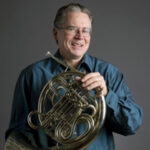Legacy of Horn

Anton Horner, who grew up in both Austria and Philadelphia, had an enormous influence on the American school of horn playing.
Horner joined the faculty at Curtis in 1924 and remained until 1942 (the American entry into World War II necessitated severe budget cuts which left the brass and percussion departments almost completely shuttered for five years). As a performer and teacher, Horner impressed upon his students the utmost importance of tone quality. James Thurmond (’35), one of Horner’s first two students at Curtis, lauded his mentor’s “legendary” tone, writing, “the tone was so soft, pure, free, and ethereal, that sometimes one would wonder if a human being were actually playing.” In the early years of the school, Leopold Stokowski directed the faculty to play alongside their students in the Curtis Symphony Orchestra; as Thurmond recalled, students relished this intimate opportunity to hear their teachers in rehearsal and performance.
Alongside his long tenure as a performer and teacher, Horner encouraged a revolution in the very instruments American horn players used. In 1902, the year he joined the Philadelphia Orchestra under Fritz Scheel, Horner began working with the German horn manufacturer Kruspe to improve their early design of the double horn in F/B . Horner introduced this silver double horn model to the United States and continued to import them into the early 1940s. With Horner’s influence, the double horn became the standard model. To this day the Kruspe model remains one of the more popular designs for American hornists.
After Horner retired from Curtis, two of his students would follow in his footsteps and assume the role of horn faculty at the school. James Chambers (’41) spent one year with the Pittsburgh Symphony before returning to Philadelphia to teach at Curtis. He soon moved to New York, where he held long and celebrated tenures with the New York Philharmonic and at the Juilliard School. During his time in the Philharmonic, Chambers became a favorite of music director Leonard Bernstein (Conducting ’41), who fondly remembered Chambers’s “magnificent” playing on his early Philharmonic recordings of Gustav Mahler. One of Chambers’s many students in New York, Myron Bloom, would join the horn faculty at Curtis in 1982, teaching alongside Mason Jones (’38).
In his 49 years serving as horn faculty, Mason Jones continued to uphold the lessons imparted to him by Horner. Jones led his students, regardless of age or background, through the same collection of etudes that he had completed under Horner. After retiring, Jones remarked upon his philosophy of teaching, echoing the ethos of founding faculty such as Marcel Tabuteau: “As a matter of fact, a lot of the Curtis teaching is based on getting young students who are attuned to the instrument or to the voice but who are technically not ready— and to build on that. As long as they have the inherent talent in the beginning, it’s not necessarily finished, but it’s something that you build on.”
Following Jones’s and Bloom’s retirements from Curtis, yet another of James Chambers’s students assumed the role of horn faculty at Curtis. Jerome Ashby, who studied with Chambers at the Juilliard School, broke barriers as the first Black principal horn of any Mexican orchestra, as well as the New York Philharmonic’s first Black hornist following his 1979 appointment at the invitation of Zubin Mehta. On a historic occasion, Ashby’s performance celebrated the literal breaking of barriers: on Christmas Day 1989, he performed the fourth horn solo in Beethoven’s Ninth Symphony under the direction of Leonard Bernstein at a concert celebrating the fall of the Berlin Wall.
The newest generation of Curtis horn students, including those six currently enrolled, benefit from the shared instruction of Jennifer Montone and Jeffrey Lang who, like many of their predecessors, fill first-desk positions in the Philadelphia Orchestra as principal horn and associate principal, respectively.
Faculty Timeline
-

Anton Horner
Horn — 1924-42 -

James Chambers
Horn — 1942-46 -

Mason Jones*§
Horn — 1946-95 -

Myron Bloom
Horn — 1982-99 -

Jerome Ashby
Horn — 2000-07 -

Jennifer Montone*§
Horn — 2007-Present -

Jeffrey Lang*§
Horn — 2012-Present
- 1925
- First Horn Alum
August H. Fischer
- 6
- Horn Studio
There are up to 6 horn students studying at Curtis in any given year.
Legacy of Curtis
Leading to its centennial year, Curtis began a multi-year project celebrating each of the school’s major areas of study.




